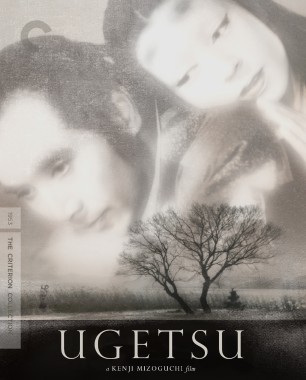Ugetsu

By the time he made Ugetsu, Kenji Mizoguchi was already an elder statesman of Japanese cinema, fiercely revered by Akira Kurosawa and other directors of a younger generation. And with this exquisite ghost story, a fatalistic wartime tragedy derived from stories by Akinari Ueda and Guy de Maupassant, he created a touchstone of his art, his long takes and sweeping camera guiding the viewer through a delirious narrative about two villagers whose pursuit of fame and fortune leads them far astray from their loyal wives. Moving between the terrestrial and the otherworldly, Ugetsu reveals essential truths about the ravages of war, the plight of women, and the pride of men.
Ugetsu was restored by The Film Foundation and Kadokawa Corporation at Cineric Laboratories in New York. Special thanks to Masahiro Miyajima and Martin Scorsese for their consultation on this restoration. Restoration funding provided by the Hollywood Foreign Press Association in association with The Film Foundation and Kadokawa Corporation.
4K UHD + BLU-RAY SPECIAL EDITION FEATURES
- 4K digital restoration, with uncompressed monaural soundtrack
- One 4K UHD disc of the film and one Blu-ray with the film and special features
- Audio commentary by critic, filmmaker, and festival programmer Tony Rayns
- Kenji Mizoguchi: The Life of a Film Director, a 1975 documentary by Kaneto Shindo
- Two Worlds Intertwined, a 2005 appreciation of Ugetsu by Masahiro Shinoda
- Process and Production, a 2005 interview with Tokuzo Tanaka, first assistant director on Ugetsu
- Interview from 1992 with cinematographer Kazuo Miyagawa
- Trailers
- PLUS: An essay by film critic Phillip Lopate and three short stories that inspired the film
Cover by Michael Boland
Collector's Sets
4K UHD + BLU-RAY SPECIAL EDITION FEATURES
- 4K digital restoration, with uncompressed monaural soundtrack
- One 4K UHD disc of the film and one Blu-ray with the film and special features
- Audio commentary by critic, filmmaker, and festival programmer Tony Rayns
- Kenji Mizoguchi: The Life of a Film Director, a 1975 documentary by Kaneto Shindo
- Two Worlds Intertwined, a 2005 appreciation of Ugetsu by Masahiro Shinoda
- Process and Production, a 2005 interview with Tokuzo Tanaka, first assistant director on Ugetsu
- Interview from 1992 with cinematographer Kazuo Miyagawa
- Trailers
- PLUS: An essay by film critic Phillip Lopate and three short stories that inspired the film
Cover by Michael Boland

Cast
- Machiko Kyo
- Lady Wakasa
- Masayuki Mori
- Genjuro
- Kinuyo Tanaka
- Miyagi
- Sakae Ozawa
- Tobei
- Mitsuko Mito
- Ohama
- Kikue Mori
- Ukon
- Ryosuke Kagawa
- Village headman
- Ichiro Amano
- Boatman
- Sugisaku Aoyama
- Old priest
- Ichisaburo Sawamura
- Genichi
Credits
- Director
- Kenji Mizoguchi
- Producer
- Masaichi Nagata
- From Tales of Moonlight and Rain by
- Akinari Ueda
- Screenplay
- Matsutaro Kawaguchi
- Screenplay
- Yoshikata Yoda
- Director of photography
- Kazuo Miyagawa
- Art director
- Kisaku Ito
- Set designer
- Uichiro Yamamoto
- Costumes
- Shima Yoshimi
- Costumes
- Tadaoto Kainosho
- Music
- Fumio Hayasaka
- Sound
- Iwao Otani
- Sound
- Akira Suzuki
- Editor
- Mitsuzo Miyata
- Makeup
- Zenya Fukuyama
- Hair
- Ritsu Hanai
A scene from Ugetsu

























